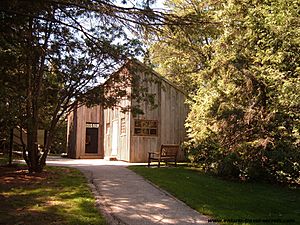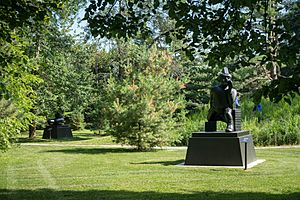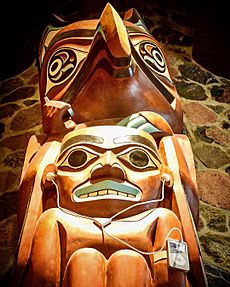McMichael Canadian Art Collection facts for kids
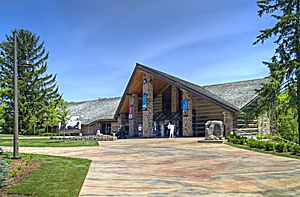
Entrance to the main building
|
|
| Established | 8 July 1965 |
|---|---|
| Location | 10365 Islington Avenue Vaughan, Ontario, Canada |
| Type | Art museum |
| Visitors | 105,208 |
| Architect | Leo Venchiarutti |
| Owner | Government of Ontario |
The McMichael Canadian Art Collection (often called MCAC) is a special art museum in Kleinburg, Ontario, Canada. It sits on a huge 100-acre (about 40-hectare) property. This property includes the main museum building, a beautiful sculpture garden, walking trails, and even a cemetery. Six famous artists from the Group of Seven are buried there.
The museum's story began in 1955. Robert and Signe McMichael started collecting art, especially from artists like the Group of Seven. They showed these artworks in their home in Kleinburg. In 1965, the McMichaels decided to give their art collection and their property to the Government of Ontario. This gift helped create the art museum we know today.
The museum first opened to the public in 1966. It was initially focused on the Group of Seven artists. Over time, its mission grew to include modern Canadian art and art from Indigenous artists. Today, the museum's permanent collection has more than 6,500 artworks by Canadian artists. It also keeps a special collection of drawings and prints by Inuit artists from Kinngait. The McMichael museum often hosts exciting art shows, usually about Canadian art.
Contents
How the McMichael Art Collection Started
In 1951, Robert and Signe McMichael bought a 10-acre (about 4-hectare) piece of land in Kleinburg, Ontario. They built their home there in 1954. The McMichaels loved art and began collecting paintings by the Group of Seven. Their very first painting was by Tom Thomson, bought in 1955.
In 1962, they even moved Tom Thomson's old art studio from Toronto to their property. They worked to fix it up. By 1965, their personal collection had grown to 194 paintings!
The McMichaels started showing their art collection to visitors on weekends. More and more people came, so they thought about creating a public art space. On November 18, 1965, they made an agreement with the Government of Ontario. The McMichaels would donate their art and property. In return, the government would take care of the museum and keep the "spirit of the collection" alive. The McMichaels even continued to live on the property for a while.
The property was turned into an art museum, and it officially opened on July 8, 1966. It was first called the McMichael Conservation Collection of Art. Robert McMichael was the museum's first director until 1981.
A Special Resting Place for Artists
In 1968, A. Y. Jackson, a member of the Group of Seven, suggested something unique. He proposed that the museum's grounds could be a burial place for himself and other Group of Seven artists. The museum agreed, and a special cemetery was created on the property. Before he passed away, Jackson spent a lot of time painting there. He was even the museum's artist-in-residence.
Six members of the Group of Seven are buried at the McMichael cemetery. These include A. J. Casson, Lawren Harris, A. Y. Jackson, Frank Johnston, Arthur Lismer, and Frederick Varley.
Growing the Collection and Mission
The museum's mission changed over the years. In 1969, it expanded to include other artworks that showed Canada's "cultural heritage." This change was approved by Robert McMichael and the Premier of Ontario, John Robarts.
As more people visited and the collection grew, the museum became an official organization of Ontario in 1972. This meant it had its own special law, the McMichael Canadian Art Collection Act.
There were some disagreements in the 1990s about the museum's focus. Robert McMichael felt the museum was moving away from its original goal of showing Canadian landscape art, especially by the Group of Seven. After some legal discussions, a new law was passed in 2000. This law helped bring the museum's focus back to Canadian landscape art and the Group of Seven.
However, in 2011, another change happened. A new law expanded the museum's mission again. It now officially includes modern Canadian artists and Indigenous Canadian artists. This change also removed some old rules about what the museum could show.
Exploring the Museum Grounds
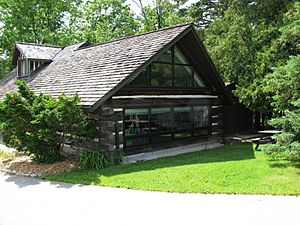
The McMichael Canadian Art Collection is located in Kleinburg, a village in Vaughan, Ontario. The museum's grounds cover 100 acres (about 40 hectares) in the beautiful Humber River Valley. The landscape itself was carefully designed to match the art inside. The McMichaels planted over 500 cedar trees to recreate the kinds of landscapes the Group of Seven often painted.
On the grounds, you'll find several buildings. There's the main museum building, the Meeting House, Pine Cottage, and Tom Thomson's studio. Pine Cottage is where the museum's art studio is located. You can also enjoy walking trails, a sculpture garden, and the McMichael cemetery. The Ivan Eyre Sculpture Garden displays sculptures from the museum's collection and other loaned artworks.
The Main Museum Building
The main museum building was designed by architect Leo Venchiarutti. It was first finished in 1954 and has been expanded several times since. From 1981 to 1983, the building had a big renovation.
The main building is about 85,000 square feet (about 7,900 square meters). It was once called Tapawingo, which supposedly means "place of joy" in some Indigenous languages.
The building has unique features like log and barn-board walls and stone fireplaces. These details help create a feeling that matches Canadian landscape art. It also has huge floor-to-ceiling windows that offer amazing views of the Humber River Valley. Inside, there are 14 viewing halls, a gift shop, and a restaurant. One area, the Western Canada Gallery, has a 40-foot-long cedar bench and cedar arches with carvings by Doug Cranmer.
The Permanent Art Collection
The McMichael Canadian Art Collection is special because its permanent collection focuses only on works by Canadian artists. It all started with Robert and Signe McMichael's personal collection in 1955. When they donated it in 1965, it had 187 artworks. Today, the collection has grown to over 6,500 works.
The museum's collection is divided into four main areas: modern art, First Nations art, the Group of Seven, and Inuit art.
While the museum first focused on Canadian landscape art and the Group of Seven, it now includes many other Canadian artists. Its goal is to collect and preserve art by artists who have helped shape Canadian art. This includes the Group of Seven, their friends, and especially Indigenous Canadians. Besides the Group of Seven, you can find works by artists like Cornelius Krieghoff, David Milne, and Robert Pilot. In 2014, the museum received 50 paintings from artists in Quebec. Famous French Canadian artists in the collection include Paul-Émile Borduas, Marc-Aurèle de Foy Suzor-Coté, and Jean-Paul Riopelle.
The museum officially started its modern art collection in 2011. However, it had already acquired some modern pieces before then. Artists like Jack Bush, Colleen Heslin, and Mary Pratt are featured in this collection. Outside, the sculpture garden displays many sculptures, including nine by Ivan Eyre.
Indigenous Canadian Art
The McMichael museum was one of the first art museums to include art by Indigenous artists in its collection. In 1957, the McMichaels bought their first piece by a Haida artist, Bill Reid. Their collection of Inuit stone carvings and West Coast First Nations wood carvings, masks, and totem poles were part of the gift to the province in 1965. By 1981, about 42% of the museum's collection was by Indigenous Canadian artists.
Many Indigenous artworks were added between 1982 and 2000. During this time, the museum's mission included Indigenous Canadian art as part of "Canadian cultural heritage." The collection also grew to include modern Indigenous art. In 1994, the museum even had its first First Nations curator-in-residence.
However, in 2000, the museum's mission changed again, focusing more on the Group of Seven. This meant many Indigenous Canadian artworks were put into storage. They stayed there until 2004, when they were brought back out for display. Finally, in 2011, Indigenous Canadian art was officially brought back into the museum's main mission.
Library and Archives
The museum also has a library and archives. These hold many important items like artist files, books, exhibition catalogs, letters, and photographs. They specialize in information about the Group of Seven and Indigenous Canadian art.
The archives include special collections. The Arthur Lismer Collection, given by Lismer himself, has documents and artworks from the 1890s to the 1960s. It contains over 900 drawings, sketches, and 1300 original photographs. The Norman Hallendy Archives, finished in 2015, has over 12,000 photographs, audio and video recordings, maps, and research files about Inuit culture.
The archives also store over 100,000 drawings, prints, and sculptures from the West Baffin Eskimo Co-operative Ltd.. This is a group of artists from Cape Dorset, Nunavut. Their works were moved to the McMichael's archive in 1992 after a fire destroyed their studio. The museum has made digital copies of many of these works from 1959 to 1988.
Selected Works from the Collection
-
A. Y. Jackson. Cathedral at Ypres, Belgium, 1917
-
Emily Carr, Shoreline, 1936
See also
- List of art museums
- List of museums in Ontario


